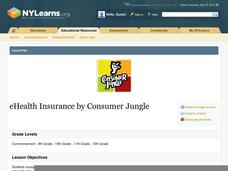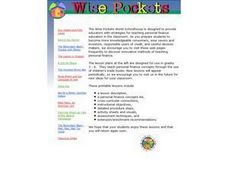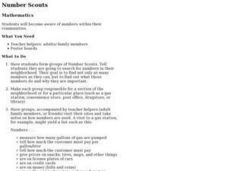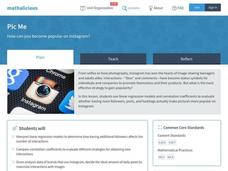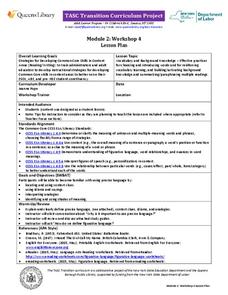Federal Reserve Bank
“W” Is for Wages, W-4 and W-2
Don't let your young adults get lost in the alphabet soup of their paychecks and federal income taxes. Using sample pay stubs and reproductions of government forms, your class members will identify the purpose of such forms as a W-4 and...
PLS 3rd Learning
eHealth Insurance
Comparison shop for health insurance? Yep. Young adults compare and contrast several health insurance plans to determine which would provide the most coverage at the best price. They discuss and work through deductibles, premiums, and...
Curated OER
Wise Pockets
Using children's picture books and role-playing activities, youngsters begin to learn about personal finance management. These lesson plans are engaging and intend to endow pupils with skills for making wise decisions with money as they...
Federal Reserve Bank
Cash the Check and Track the Dough
From checking and savings accounts to learning the importance of maintaining records and balancing a bank account, prepare your students to become financially independent and savvy adults, and explore all the intricacies of owning a bank...
New York State Education Department
TASC Transition Curriculum: Workshop 3
Teachers turning into students? It's not Freaky Friday! It's a thoughtful workshop that teaches participants how to plan professional development for staff. Third in a 15-part series, the workshop provides a platform for the other...
Visa
Credit Cards
Choosing your first credit card can often be an intimidating and confusing experience for young adults. Give your pupils the foundational knowledge they need for tackling this process head-on, including learning to...
Visa
Buying a Home
What is the difference between buying and renting a home? Learners become more informed consumers and financially literate adults after developing foundational knowledge of the home-buying process.
Visa
Home Sweet Home: Purchasing a Place
While the process of buying a home can certainly be overwhelming, give your young adults a leg up for their future by introducing them to the components of a mortgage, as well as exploring the basic concept of credit and how to become...
New York State Education Department
TASC Transition Curriculum: Workshop 2
Flipped classrooms and online tools killed the chalkboard! An awesome, hands-on technology workshop asks teachers across all content areas. to examine model lessons, become familiar with research, and explore tech tools they can...
Curated OER
Oversized Inc
Fourth graders become familiar with fractional parts of a ruler. In this measurement lesson, 4th graders measure various objects to an 1/8 of an inch. Students measure a piece of paper based on teacher direction....
Granite School District
Activities that Build Number Sense
Have fun while building the number sense of young mathematicians with this list of ten-frame learning games. From developing cardinality and counting skills to learning place value and basic addition strategies, ten-frames are excellent...
Curated OER
EBT-rimental
Students engage in a lesson that gives them the tools needed to become knowledgeable credit consumers. The companion website for the ITV program TV-411 is used to provide learners with an interactive experience of what credit has to offer.
Curated OER
Avoiding Consumer Fraud: Financial Scams and Schemes
Young consumers get a hefty dose of information on how fraud can put their financial health at risk. The resource provides detailed lecture notes, scaffolded notetaking sheets, vocabulary worksheets, transparencies, and seven links to...
Visa
Smooth Sailing: Exploring Insurance and Estate Planning
While purchasing insurance and estate planning may seem like a rather irrelevant topic for high school students, introducing this concept now can help your learners develop a solid foundation of financial literacy that will...
Curated OER
Youth vs. Adult Employment
Students investigate the unemployment rate in Canada. In this statistics instructional activity, students collect data on youth finding jobs, graph and analyze the data. This assignment raises awareness of the employment problems in Canada.
Curated OER
Financial Contracts
Prepare your class for the real world and learn the basics about credit and the principles behind using it wisely. The activity includes handouts that explain the necessary vocabulary and concepts to understanding credit. After reviewing...
Curated OER
The Catastrophe Clan
Students participate in a financial project and identify the three c's of credit. In this credit card lesson, students define and understand how to use credit wisely. Students become familiar with banking terms and types of...
Federal Reserve Bank
Keep the Currency
Each day, people throw currency away in different ways because of a lack of financial knowledge. Introduce your learners to the importance of financial literacy and assess their understanding of banking and personal finance.
Curated OER
Number Scouts
Students become aware of numbers within their communities. They search for numbers in their neighborhood.
Curated OER
Money Management Part III: Savings Accounts and Cash vs. Credit
Help your class understand the importance of saving and managing their money. Here is part three to a unit on credit, cash, and savings. Learners discuss savings accounts and the idea that a budget plan can help them avoid costly credit...
Curated OER
Check It Out
Students discuss the many processes involved with personal banking. They create their own budget based on their career choices. They also practice balancing a checkbook.
Mathalicious
Pic Me!
Finally! Math and Instagram have come together to discuss the correlation between likes and followers. High schoolers can't help but want to discover what makes one account more popular than another by developing a line of best fit and...
Curated OER
The Class Trip
Mrs. Moore's class is trying to earn money for a trip to the science museum, but how much more do they need? Solve this problem with your own class as they develop their ability to model real-life situations algebraically. As an added...
New York State Education Department
TASC Transition Curriculum: Workshop 4
Why is it important to use precise language? Participants explore this question in the fourth activity in a series of 15 on effective instruction. Perfect for all content areas, the activity promotes appropriate language choice through...



